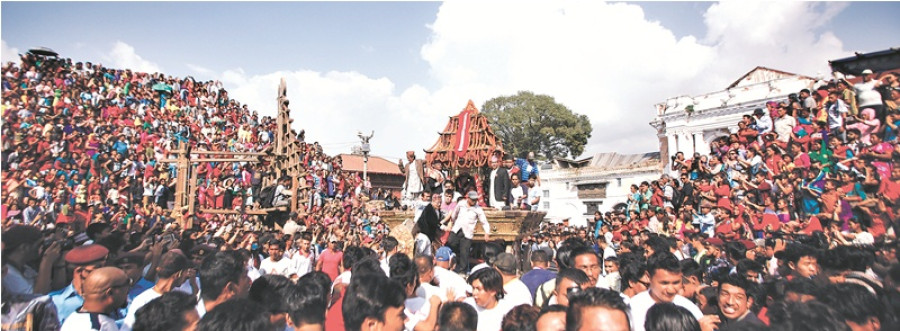Miscellaneous
Building bridges from the debris
In a catastrophic year for the tangible heritages of the Kathmandu Valley, it is the unwavering faith of its inhabitants that will emerge as the silver lining
Marissa Taylor
When the April earthquakes rattled through the Valley, bringing down temples and sacred spaces, it, understandably, felt like an end of an era. As the Valley’s denizens picked up the pieces of the Maju Dega in Kathmandu, Char Narayan in Patan and Fasi Dega in Bhaktapur, a morbid sense of doom was all encompassing. How, in the modern day of endless bureaucratic red-tape and fatalistic inaction, could these defining edifices of Kathmandu’s urban cityscape be rebuilt? The temples played a pivotal role not just as places of reverence and worship but also in the Jatras and festivals that bind the inhabitants together as a community. And with these spaces now hauntingly vacant, many had wondered if the Valley’s traditions too would fall prey to the slippery slope of indifference.
Yet, almost a year later, such prophecies of doom have not come to pass. In fact, in many ways, the quakes have served as a rallying cry. Now, as a religious conference that has not seen the light of day for 250 years is being revived later this month, there are those who are quietly wondering if the earthquakes have indeed sparked a “mini-renaissance”.

250 years in the making
Yagya Man Pati Bajracharya is the eldest Acharya of the Dey Achaa Guthi. At 75 years old, although he doesn’t look it, he is leading the guthi as it holds the annual conference of Acharyas that is going to be held sequentially in Shantipur in Swoyambhu and Hanuman Dhoka, after a 250-year hiatus.
“The leader of the guthi is selected in respect to seniority. A lot of people pass on without getting their turn to lead the guthi. Even I had to wait 75 years for it!” says Yagya Man, with jest, as we sit out on a warm spring morning, while a puja commences in the background. Preparations are ongoing for the conference that is to be held on March 31 and April 1.
“The pujas at Hanuman Dhoka were an initiation of Pratap Malla himself. We are trying to establish what was practiced, so it doesn’t die with this generation,” says Yagya Man. “During the Malla regime, two of the high priests performed the Guhye (sacred) puja at Shantipur while two performed the puja at Hanuman Dhoka,” he adds. The guthi has taken permission from the municipality and the Hanuman Dhoka Museum Development Committee, under the Department of Archaeology, and are all set to reopen doors that have been closed for two-and-a-half centuries.
Besides being a conglomeration of the four geographically divided groups: Thani Pui, Dathu Pui, Kwane Pui and the Layaku Pui, where the eldest Acharya from each division runs the annual conference, this religious gathering is also the welcoming ceremony of new Acharyas which is followed by the sacred puja at Shantipur.
“Guhye pujas are sacred. They have to be done in areas away from prying eyes as it may inflict harm upon those who come across it. But after the Mallas were ousted, the pujas stopped taking place at Hanuman Dhoka. The guthi, however, over the centuries, found different places to conduct the puja at various bahals. But that is not the proper way of conducting such a sacred ritual,” says a solemn Yagya Man, adding, “The world has become a strange place to live in. People have no respect or fear of the gods; deities are smuggled without the slightest of fears. All we are trying to do is to keep our tradition, our practices and our faith alive.”

Building bridges
In a world that is already over-run by consumerism and has little faith in the heavens, the earthquakes, seemingly, did not do much to help. According to the Department of Archaeology, the earthquakes affected a total of 691 buildings of historic value in 16 districts all over Nepal, of which 131 were completely destroyed and 560 were damaged—sweeping with it much of our tangible heritage. This loss of tangible heritage was a deep blow for the religious, but the intangible heritage, the legacy that passes on a sense of identity and belongingness, is very much alive, and is, in some sense, the light at the end of the tunnel.
Dr Sudarshan Raj Tiwari, Professor of Architecture at Tribhuvan University, who is currently involved with the reconstruction of the Pancha Mukhi Hanuman Temple at Hanuman Dhoka, echoes a similar sentiment. “Over the years, the scale of rituals has been reduced dramatically. And if rehabilitation of culture is happening, we should encourage it. In the process of doing that, however, it’s not that we cannot start something new as well,” says Tiwari, “By encouraging community participation in performing intangible activities, it is the conservation of the intangible. By doing this you create a link between the physical heritage and the people.”
Amidst traditions that are being reinstated and links that are being re-forged, are the three defining festivals of the three cities of Kathmandu, Bhaktapur and Patan. “The three jatras—Indra Jatra of Kathmandu, Rato Machindranath Rath Jatra of Patan and Bisket Jatra of Bhaktapur—are the cornerstones of the three cities. They are synonymous with the identity of the inhabitants and their faith,” says Om Prasad Dhaubhadel, a cultural expert.
Cultural cornerstones

The jatra of the Rato Machindranath is perhaps the most visually striking and most fervently celebrated festivals of the Valley. Last year, the highly-anticipated Barha Barse Mela, where the red God’s chariot is pulled all the way from neighbouring Bungamati to Patan, was in full swing when the earthquakes came rattling the obelisk chariot. On April 25, the chariot was stationed in Chaisikot near Bhaisipati—a fraction of the 8 km procession complete. The chariot saw significant damages in the quake and the aftershock and would need major rebuilding if it were to complete the journey to Patan and back. Furthermore, the tekas (wooden beams used as support for structurally-weakened houses) peppered throughout the alleyways of Patan made the procession seemingly impossible. At the time, it felt, that something had to give.
“These jatras are elaborate rituals that keep centuries old culture standing,” says Tirthaman Maharjan, coordinator of the committee that organises the Barha Barse Mela, “and stopping it, even at the face of such calamitous circumstances, was never in question.” Despite the logistical nightmare, the locals of Patan pooled together resources to ensure the chariot was rebuilt and taken through the exact route it would have, had the earthquakes not halted the jatra. The organisers even went as far as removing the wooden tekas momentarily so that the procession could eek through. “Looking back, I am amazed,” Tirthman recalls fondly, “if it wasn’t for all the sadness surrounding the loss from the earthquakes, I would argue that this was one of the most fervently celebrated Machindranath jatras of a generation or two.”
The same sentiments were seen in Kathmandu, where during the Indra Jatra, three chariots—of the Kumari, Ganesh and Kumar—were taken through the old-town, and now are rife in Bhaktapur, a town where festivals occur every two weeks. The Bisket Jatra, which has been observed since the Lichhavi era, if not earlier, is observed at the arrival of spring. The festival closes the Bikram Sambat calendar and steps onto a new one.
“The only major problem we are facing right now is the problem of the wooden pillars. Because of the earthquakes, the houses are very weak and are standing in support of the wooden pillars in every alley. The rath of Bisket Jatra is the biggest among all three jatras and it may prove problematic. We have held meetings in the Leela Prasashan Karyalaya to reach a solution,” says Narendra Joshi, Head Priest at the Taleju temple.
“All festivals, all year round, have been celebrated despite the hardships inflicted on the people,” says Dhaubadhel, “the Bisket Jatra, which is the last festival of the Nepali calendar marks that, and we intend to do all that is necessary to ensure that it is done right.”
With an expected number of 3,000 Acharyas scheduled to attend the conference and preparations for the Bisket Jatra in full swing, the faith of people seems unshaken by the earthquakes and a sense of identity with their cultures is still palpably intact. It seems that the light at the end of the tunnel is not as far as you’d think.




 12.12°C Kathmandu
12.12°C Kathmandu








%20(1).jpg&w=300&height=200)

